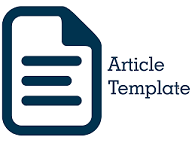Family Literacy of Baduy Tribe: an Ethnographic Study
Abstract
The purpose of this ethnographic study was to reveal the family literacy practices of Baduy tribe at Lebak Regency, Banten Province. Family literacy in this paper refers to an intergenerational learning in in Baduy tribe families, which include how family learns, uses reading and writing activities to do daily task, and other literacy activities to maintain family relationship. Family literacy in Baduy is called intergenerational learning in which the learning method that is practiced in families and communities leads to the creation of a process of cultural and educational transformation in a society. This study utilizes ethnographic approach by conducting interviews with sixteen families (father and mother) and eighteen children and youth. Data analysis includes the four stages of ethnographic data analysis, namely domain, taxonomy, component and theme analysis. The results showed that family literacy in the Baduy tribe last a lifetime, starting from children aged 7 days to 10 years. The literacy activities of the Baduy family cannot be separated from the their culture and beliefs. This culture is passed down from generation to generation with an intergenerational learning approach, it is the process of delivering literacy that is practiced directly within the family.
Full Text:
PDFReferences
Arsa, D., Atmazaki, A., & Juita, N. (2019). Literasi Awal pada Anak Usia Dini Suku Anak Dalam Dharmasraya. Jurnal Obsesi : Jurnal Pendidikan Anak Usia Dini, 3(1), 127. https://doi.org/10.31004/obsesi.v3i1.159
Coombs, P. H. (1973). New Paths to Learning for Rural Children and Youth. New York,NY: International Council for Educational Development.
Corrigan, T., Mcnamara, G., & O’Hara, J. (2013). Intergenerational Learning: A Valuable Learning Experience for Higher Education Students. Egitim Arastirmalari-Eurasian Journal of Educational Research, 13(52), 117–136.
Coull, Y. (2018). Learning Through Intergenerational Practice Generations Working Together 2 Learning Through Intergenerational Practice. Retrieved from http://generationsworkingtogether.org/downloads/5252d276ca45a-GWT brochure FINAL.pdf
Creswell, J. W. (2013). Qualitative inquiry & research design : choosing among five approaches (3rd ed.). Thousand Oaks, California: Sage Publications.
Fajriyah, L. (2018). Pengembangan Literasi Emergen pada Anak Usia Dini. Proceedings of The ICECRS.
George, J. M., & Jones, G. R. (2014). Understanding and managing organizational behaviour. New Jersey: Pearson Education.
Hanemann, U., Mccaffery, J., Newell-jones, K., & Scarpino, C. (2017). Guidelines for Family Literacy and Guidelines for Family Literacy and Learning Programmes.
Inten, D. N. (2017). Peran Keluarga dalam Menanamkan Literasi Dini pada Anak. Golden Age, 1(1), 23–32. Retrieved from file:///Users/ilarosmilawati/Downloads/2689-9568-2-PB.pdf
Iskandar, J., & Iskandar, B. S. (2017). Local knowledge of the baduy community of south banten (Indonesia) on the traditional landscapes. Biodiversitas, 18(3), 928–938. https://doi.org/10.13057/biodiv/d180309
Jacobs, J. (2012). Orang Baduy dari Banten. Bandung: Primaco Akademika & Judistira Garna Foundation.
Kaplan, M., Kusano, A., Tsuji, I., & Hisamichi, S. (1998). Intergenerational Programs: Support for Children, Youth, and Elders in Japan. New York,NY: State University of New York Press.
Kernan, M., & Cortellesi, G. (2019). Intergenerational Learning in Practice. https://doi.org/10.4324/9780429431616
Kolb, D. A. (1984). Experiential Learning: Experience as the Source of Learning and Development. New Jersey: Prentice Hall.
Lase, D. (2020). Pembelajaran Antargenerasi: Sebuah Kajian Literatur. https://doi.org/10.31235/osf.io/bsja3
Lupou, R., Dorobanţu, A., & Fiore, F. (2010). A new lifelong learning model based on intergenerational exchange: Premises and foreseen benefits. Procedia - Social and Behavioral Sciences, 2(2), 2761–2765. https://doi.org/10.1016/j.sbspro.2010.03.411
Meriam, S. B. (1998). Qualitative research and case study applications in education (Rev. and expanded. ed). San Francisco, CA: Jossey-Bass.
Muttaqien, Z. (2019). Peran Perempuan dalam Tradisi Sunda Wiwitan. Khazanah Theologia, 1(1), 23–39. https://doi.org/10.15575/kt.v1i1.7123
Permatasari, A. (2015). Membangun Kualitas Bangsa dengan Budaya Literasi. Seminar Nasional Bulan Bahasa UNIB, 146–156. Bengkulu.
Putnam, R. D. (1993). Making Democracy Work: Civic Traditions in Modern Italy. Princeton, N.J: Princenton University Press.
Sager, S. (2008). The Sky is our Roof, the Earth our Floor Orang Rimba Customs and Religion in the Bukit Duabelas region of Jambi, Sumatra. (May). Retrieved from https://openresearch-repository.anu.edu.au/handle/1885/49351
Sánchez, M., Whitehouse, P., & Johnston, L. (2018). Intergenerational Learning and Education in Schools and Beyond. Journal of Intergenerational Relationships, 16(1–2), 1–4. https://doi.org/10.1080/15350770.2018.1404380
Sharma, R. (2017). Intergenerational Learning. Journal of Gerontology & Geriatric Research, 06(03), 9–10. https://doi.org/10.4172/2167-7182.1000432
Sholih, Rosmilawati, I., & Darmawan, D. (2020). Intergenerational Learning: Valuable Learning Experiences for Baduy Youth. Proceedings of the International Conference on Science and Education and Technology (ISET 2019), 443(Iset 2019), 501–504. Retrieved from https://www.atlantis-press.com/article/125941356
Spradley, J. P. (1994). Participant Observation. New York,NY: Mc. Graw-Hill Book Comparation.
Sutoto. (2017). THE TRANSFORMATION OF BADUY LEARNING CULTURE IN. Jurnal Pendidikan Dan Pengajaran, 50(2), 86–97.
UNESCO. (2020). Unlocking the potential of family and intergenerational learning. In UNESCO Covid-19 Eduaction Response. Retrieved from https://unesdoc.unesco.org/ark:/48223/pf0000373512
UNESCO Institute for lifelong learning. (2015). Learning families: Integrational approaches to literacy teaching and learning. https://doi.org/10.4324/9780203415870
Wartomo. (2017). Membangun Budaya Literasi Sebagai Upaya Optimalisasi Perkembangan Bahasa Anak Usia Dini. Retrieved from http://repository.uinjkt.ac.id/dspace/bitstream/123456789/36571/2/SAKINAH MAWADAH R-FAH.pdf
Zid, M., Hidayat, R., & Mukhtar, S. (2018). The model of Baduy’s community system to anticipate the social environment change. 22(2), 1–11.
DOI: https://doi.org/10.24036/kolokium-pls.v8i2.434
Refbacks
- There are currently no refbacks.

